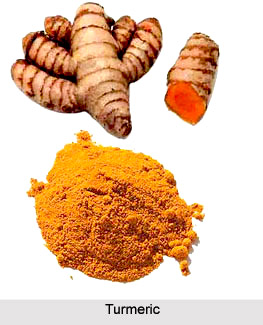 Uses of Turmeric in Cuisine are found to be of an everyday occurrence, heavily utilised for each and every single purpose in every kind of household. The various uses of turmeric however perhaps are overshadowed by its splendid culinary and cooking usages, for which "Haldi" is the most popular and most admired. Turmeric plays the most mandatory role, acting as one of the principle ingredients of curry powder. Turmeric is mostly recommended to be used as an ultimate substitute for saffron. It adds a warm, mild aroma and distinctive yellow colour to foods.
Uses of Turmeric in Cuisine are found to be of an everyday occurrence, heavily utilised for each and every single purpose in every kind of household. The various uses of turmeric however perhaps are overshadowed by its splendid culinary and cooking usages, for which "Haldi" is the most popular and most admired. Turmeric plays the most mandatory role, acting as one of the principle ingredients of curry powder. Turmeric is mostly recommended to be used as an ultimate substitute for saffron. It adds a warm, mild aroma and distinctive yellow colour to foods.
Turmeric belongs as a member to the "Curcuma" botanical group, which is part of the ginger family of herbs - the "Zingiberaceae". The root and underground stem of the plant is crushed and powdered into a ground format, to obtain the classic and characteristic turmeric powder. Ground turmeric is used worldwide as a flavouring, to make scrumptious curry and for its medicinal properties.
Culinary Uses of Turmeric
In Indian cuisine, turmeric is added to nearly every dish, be it non-vegetarian or vegetarian. It is used literally in uncountable non-vegetarian curries, possibly due to it successfully masking the raw pungent odour of the flesh. Besides, use of turmeric can also be witnessed in the variety of meat and vegetarian dishes, each exuding a distinct aroma due to Haldi"s quintessential taste as powder or paste. When employed in curry powders, it is usually one of the principal ingredients, providing the related yellow colour.
It is also used to tint umpteen sweet dishes in India to impart a pale yellow colour to the dish, making it only turn delicious further. The Indian indigenous pickles and mustard also use turmeric to compensate for the archetypal and characteristic odour, which soon poses the chance to lose its flavour. Turmeric is also used for colouring cheeses, salad dressings, margarine, yoghurt, cakes, biscuits, popcorn, cereals, sauces, fruit drinks, table jellies, fruit dishes and an assortment of delectable food items.
It has rather ironically been touted as "poor man"s saffron", because it is known to offer a much less expensive alternative yellow colouring. Curcumin is the primary pigment in turmeric and is mostly used in various food industries as a food colour. Uses of turmeric in the food industry mainly can be found in the likes of dairy products, beverages, cereal, confectionary, ice cream, bakery and savoury products. Turmeric, quite astoundingly, also finds its usage in flavoured milk drinks, cultured milk and desserts to obtain lemon and banana colours in dairy.
Other Uses of Turmeric
Turmeric is also used as a dye in the Indian textile industry. It is utilised in the preparation of medicinal oils, ointments and poultice. It serves as a stomachic, carminative, tonic, blood purifier and an antiseptic. Uses of turmeric in cosmetics industry are basically due to the aqueous extracts, possessing excellent bio-pesticidal properties. The historical Indian and indigenised plant turmeric also finds its usage in alternative medicine, in the Ayurvedic domain.
The spice`s principal pride place however lies in the assorted Indian a-la-carte of curries and curry powders. Indeed, uses of turmeric are one such sparkling existence, which has even fascinated ancient Indian gurus and sage practitioners.




















